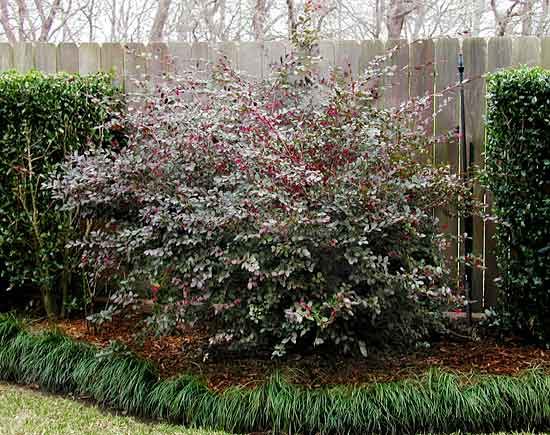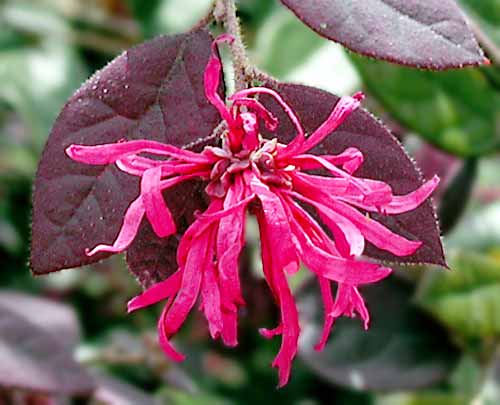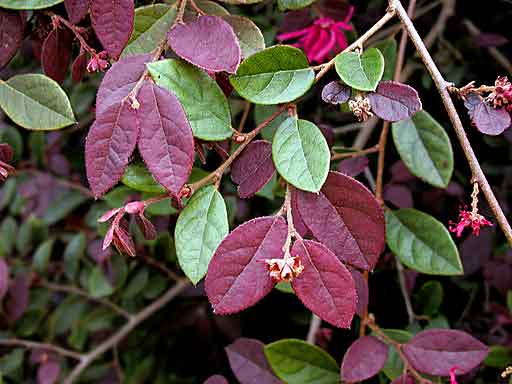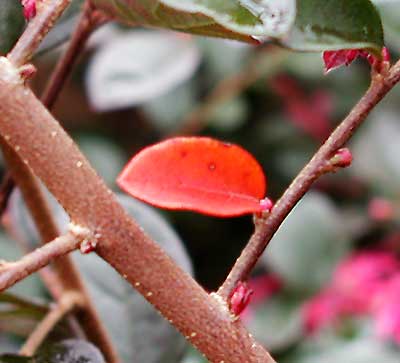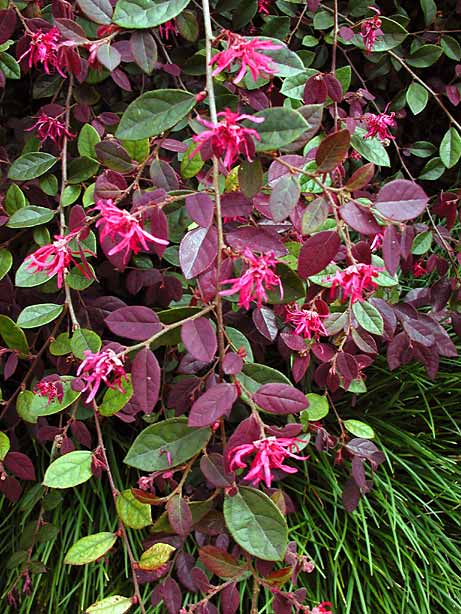|
The Plum Delight is, with a doubt, one of my favorites in my garden! It's a fast grower, with dense growth of long arching branches which can be left natural or shaped by pruning. Give this one lots of room, though, as it's spread it quite large. I had one that reached 8 feet wide when left unpruned! |
|
I had a difficult time figuring out how to prune this bush to shape it while still retaining it's natural graceful appearance. I didn't want this bush trimmed into a box shape like a hedge since that would take away what makes this one different from other plants in the garden. By accident, the lower branches were pruned back, leaving just the top branches unpruned. This turned out to be exactly what this bush needed! The pruned branches immediately put out new growth, hiding the cuts and bringing back the feathery appearance to the overall bush while the unpruned branches at the top helped to add some height to the bush. I plan to prune the branches selectively in order to help keep this shape.
|
| The flowers are very showy, reminding me of small, brilliant-pink pom-poms. In the Spring, the flowers cover the entire shrub! Once the initial show of flowers fade, you can get a new flurry of blooms by pruning the shrub. |
|
|
|
The flowers are only a part of the beauty of the Plum Delight. When new leaves emerge, they start out a deep purple color. The color lasts a long time, giving the entire bush an overall purple tone. This adds a wonderful contrast to the green plants in the garden. |
|
Randomly interspersed throughout the bush are a few leaves that turn a brilliant orange color.
If you look closely, you can see the flower buds starting to emerge. |
|
|
|
Loropetalum is very easy to grow, and once it's established, it will quickly grow very large. However, I have found that it is highly sensitive to Image, a herbicide used to kill difficult weeds, such as Yellow Nutsedge. I had two Loropetalums growing and used Image close to them. One bush totally died while the other came close to dying. It took a couple of years before the surviving bush was able to regain it's normal vigorous growth. |
|
There are quite a few different varieties of Loropetalums on the market now, many of which look similar to the Plum Delight. However, the other varieties seem to lose more leaves in the Winter, giving the bush a rather sparse appearance while the Plum Delight remains very lush and full throughout the Winter. Also, the other varieties lack the beautiful purple colored leaves. The flowers of all varieties are quite beautiful. I don't think you could go wrong with any of the Loropetalum varieties; however, the Plum Delight is the one I'd recommend the most. |
| Basic Facts |
|
| Common Name: | Chinese fringe-flower, Chinese witch hazel |
| Scientific Name: | Loropetalum chinense var rubrum 'Hines Purpleleaf' Plum Delight (Hamamelidaceae family) |
| Hardiness Zones: | 7 to 9 May require some protection in the north. See North Carolina State University's Hardiness Trials |
| Habit: | Upright and spreading, usually wider than high, long arching branches. |
| Growth Rate: | Fast growing. |
| Site Requirements: | Moist, well-drained soil. Full sun to partial shade. |
| Height: | 12 feet or more tall (mature sizes of some new selections are unknown) |
| Width: | 6 to 8 feet wide (mature sizes of some new selections are unknown) |
| Leaf: | Leaves alternate, simple, ovate-rounded, 1-2 in long, apex pointed, leaf base oblique, margin finely toothed to entire, dark green above, paler and pubescent below. |
| Flower/Fruit: | 4 narrow fringe-like pink petals, clustered at the branch tips to form pom-poms. Heavy bloom in Spring with sporadic blooms throughout the year. |
| Propagation: | Stem cuttings |
| Comments: | Use in borders, containers, hedges, screens, specimens. |
| Problems: | No major insect or disease problems. At northern edge of range, may lose foliage and flower buds in winter. |
|
| Facts Source: | University of Arkansas Horticulture |
| Facts Source: | Signature Landscapes |
| Facts Source: | Oregon State University |
| Zone Map: | USDA Plant Hardiness Zone Map |
|

